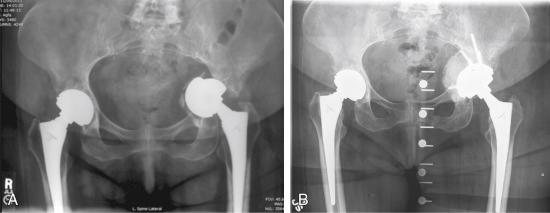Physical Address
304 North Cardinal St.
Dorchester Center, MA 02124
A 79-year-old woman presented after a primary total hip arthroplasty (THA) for a second opinion. During the primary THA, there was a fracture of her acetabulum. During surgery, the anterior and posterior columns were found to be intact. She was treated with an acetabular component with screw fixation and medial bone grafting ( Fig. 56.1 ).

A 51-year-old man presented 2 years after THA with complaints of groin pain during weight bearing. His acetabular component was loose and had migrated medially. He was treated with a larger acetabular component with peripheral fixation and bone grafting ( Fig. 56.2 ).

This chapter discusses the appropriate treatment of protrusio defects.
A protrusio defect exists when the native acetabulum or acetabular component lies medial to the ilioischial (Kohler) line.
Recognizing the degree of involvement of the supporting columns and acetabular rim is essential.
The surgeon must identify the location of the true hip center.
Revision requires adequate support and bony contact.
If inherent stability is possible with a hemispherical or elliptical shell, defects may be filled with bone graft.
Inadequate initial fixation and insufficient bony contact lead to migration of the acetabular component.
Become a Clinical Tree membership for Full access and enjoy Unlimited articles
If you are a member. Log in here